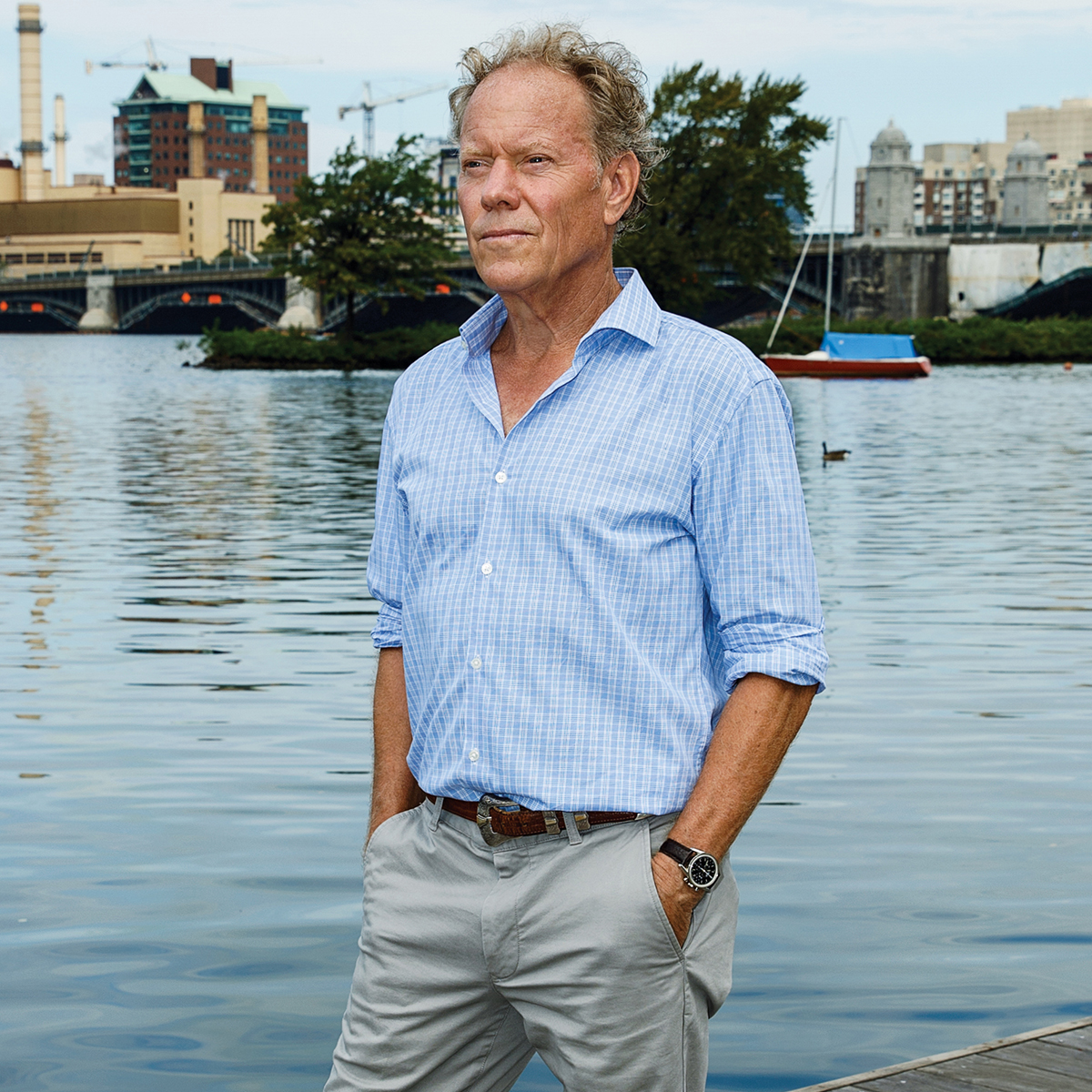A Tale of Two Rivers

John DeVillars is widely credited with leading a cleanup of the Charles in the 1990s. / Photograph by Topher Baldwin/Charles River Conservancy
One of the best illustrations of regulatory inaction, says Campbell, of the Conservation Law Foundation, is the ExxonMobil terminal in Everett, not far from where the Island End River converges with the Mystic. Campbell says CLF’s review indicated that ExxonMobil has violated its pollution discharge permit at this site at least 70 times since 2010, allowing a litany of chemicals to be swept into the Mystic. “We’re not talking about trivial violations of a permit. These are not technical violations,” he says. “The violations that we found were orders of magnitude in exceedance of their permit limits. And in many cases those exceedances were of very potent carcinogens.”
To drive the point home, Campbell prints out a two-sided spreadsheet using EPA data showing each time that CLF believes ExxonMobil violated its permit over the past five years. On July 10, 2010, for instance, the spreadsheet shows the amount of the carcinogenic chemical chrysene discharged from the facility exceeded the allowable limit by 2,848 percent. It additionally shows that on April 20, 2015, the level of acenaphthene, also carcinogenic, exceeded the allowable limit by 4,481 percent. In response, a spokesperson for ExxonMobil says the Conservation Law Foundation’s allegations are “factually inaccurate” and that the Everett terminal complies with federal and state regulations. Campbell strongly disagrees and announced that his foundation plans to sue the oil company for violating the Clean Water Act. “It’s stunning,” says Campbell, who claims that the EPA has not taken any enforcement action against Exxon. “As someone who has enforced the Clean Water Act for over 20 years, I am stunned that the EPA has allowed such egregious violations on a sustained basis, essentially with impunity.”
The EPA takes issue with this perception. “We feel like we’ve been doing a lot and we’ve been enforcing to the best of our abilities,” says Todd Borci, a water enforcement officer at the agency. To be fair, the EPA has scored a few victories. Borci points to a 2012 EPA consent decree imposed on Suffolk Downs after horse manure and urine contaminated Sales Creek, in Revere. In addition to a $1.25 million fine, the track agreed to fund $3 million worth of nearby environmental projects. That same year, Borci notes, the EPA nailed the Boston Water and Sewer Commission for having an illegal sewer hookup that spewed raw sewage into East Boston’s Constitution Beach.
Ken Moraff, a director at the EPA who worked alongside DeVillars, points out that the agency has been gutted. The staff of the New England division is approximately 25 percent smaller than it was under DeVillars, he says, and its budget has been slashed. The leaner the agency gets, the harder it is to wage the long, complex legal battles that are hallmarks of environmental law.
All of these factors have culminated in a sense of environmental ennui, and it’s the residents in the Mystic River neighborhoods who pay the price. “It’s kind of a ‘broken windows’ theory,” explains EK Khalsa, who led the Mystic River Watershed Association for nearly a decade. Every time someone is given a pass on a permit violation that would be enforced in other jurisdictions, he says, it reinforces the idea that it’s possible to get away with things on the Mystic that you wouldn’t get away with on the Charles. Every time lawmakers fail to allocate resources to set basic pollution limits on the Mystic, it falls farther behind the Charles.
Khalsa is sympathetic to the EPA’s struggles, but doesn’t accept them as excuses for setting the bar lower on the Mystic than it did on the Charles. “We should do what we did for the Charles in the Mystic,” he says. “Part of our effort is to persuade the EPA that enforcement of regulations in the Mystic is one of the essential components of improving life for Mystic River communities.”
It’s hard to argue that the Charles’s turnaround is anything short of sensational. But Khalsa worries that the ongoing disparity between the two rivers speaks to a wider trend in which affluence equals protection. “Are we going to barricade ourselves into a small number of communities, which are healthy and well?” he asks. Put another way, are we content to leave the less affluent living in communities contaminated by us all?
The most dramatic difference between the Charles River and the Mystic River isn’t a matter of pollution or water quality. It’s a matter of access.
We don’t love the Charles because it scores a B+ from the EPA. We love it because it’s a free destination open for anyone to enjoy. Should the urge strike, you can walk, run, or ride a bike along it for miles uninterrupted. There are public playgrounds, public exercise equipment, and public docks from which you can enjoy a spectacular sunset. In the fall people pile onto its bridges and shores to watch the best rowers in the world go head to head. In the summer we take to the Esplanade for fireworks and top-notch symphonic entertainment. It is an easily accessible oasis in the midst of a concrete jungle.
This is where the Mystic diverges so sharply from the Charles, and no community knows this better than Everett, where the Mystic’s shores have been swallowed up by a power plant, pumping stations, and chemical companies for more than a century. “Frankly, one of the reasons that the Charles and the Mystic look so different,” Khalsa says, “is the level of attention and the resources that have been applied to the parklands.”
Hope, though, comes in all shapes along the Mystic. Medford has long had the Mystic River Reservation, and now Somerville has greened up the Assembly Square area. Now in Everett, hope is taking the form of a 629-room resort dreamed up by the billionaire casino magnate Steve Wynn. This summer Wynn began building his $2.1 billion casino on the same spot where Monsanto once manufactured sulfuric acid. For decades the parcel of land was rife with contaminated soil and sat vacant behind a chainlink fence.
As part of the proposal, Wynn set aside $30 million to haul out all of the tainted soil and build a 6-acre park along the Mystic. It will have a living shoreline and will be open to the public year round. If all goes as planned, there will be a water shuttle that ferries commuters and visitors to downtown Boston in 15 minutes, and tree-lined pathways for walkers, runners, and cyclists. Environmentalists have lauded the park project as a major step toward a connected green space along the Mystic.
Still, struggles remain. Next door to Everett, in Chelsea, Roseann Bongiovanni continues pressuring polluters and encouraging the community to embrace the Mystic as a river that’s every bit as important as the Charles. In East Boston, not far up the road from the Condor Street Urban Wild park is a vacant lot that previously belonged to Hess Oil. The Boston Redevelopment Authority is now accepting proposals for the land and has narrowed its plans to three options: an organic composting facility, a salt mountain and distribution site, or a “maritime industrial hub.”
Fran Riley, a 73-year-old who has lived in Eastie her entire life and can recall the oily stench that wafted from the abandoned Hess tanks, is glad to see that the city is doing something with the lot, though she is underwhelmed by the options. If it were up to her, she’d turn the space into protected parkland dedicated to the battles of the Revolutionary War that unfolded along the water. “Why can’t we sit at the creek and ponder our thoughts?” she asks. “That whole area should look like the Charles River.”
For now, though, if Riley’s wish came true, it would simply mean a park that looks out at oil terminals, salt mountains, and tanker ships. The Mystic is still waiting for a hero.

